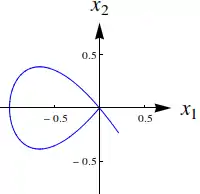Invariance of domain
Invariance of domain is a theorem in topology about homeomorphic subsets of Euclidean space ℝn. It states:
- If U is an open subset of ℝn and f : U → ℝn is an injective continuous map, then V := f(U) is open in ℝn and f is a homeomorphism between U and V.
The theorem and its proof are due to L. E. J. Brouwer, published in 1912.[1] The proof uses tools of algebraic topology, notably the Brouwer fixed point theorem.
Notes
The conclusion of the theorem can equivalently be formulated as: "f is an open map".
Normally, to check that f is a homeomorphism, one would have to verify that both f and its inverse function f −1 are continuous; the theorem says that if the domain is an open subset of ℝn and the image is also in ℝn, then continuity of f −1 is automatic. Furthermore, the theorem says that if two subsets U and V of ℝn are homeomorphic, and U is open, then V must be open as well. (Note that V is open as a subset of ℝn, and not just in the subspace topology. Openness of V in the subspace topology is automatic.) Both of these statements are not at all obvious and are not generally true if one leaves Euclidean space.

It is of crucial importance that both domain and range of f are contained in Euclidean space of the same dimension. Consider for instance the map f : (0,1) → ℝ2 defined by f(t) = (t, 0). This map is injective and continuous, the domain is an open subset of ℝ, but the image is not open in ℝ2. A more extreme example is the map g : (−1.1, 1) → ℝ2 defined by g(t) = (t 2 − 1, t 3 − t) because here g is injective and continuous but does not even yield a homeomorphism onto its image.
The theorem is also not generally true in infinite dimensions. Consider for instance the Banach space l∞ of all bounded real sequences. Define f : l∞ → l∞ as the shift f(x1, x2, ...) = (0, x1, x2, ...). Then f is injective and continuous, the domain is open in l∞, but the image is not.
Consequences
An important consequence of the domain invariance theorem is that ℝn cannot be homeomorphic to ℝm if m ≠ n. Indeed, no non-empty open subset of ℝn can be homeomorphic to any open subset of ℝm in this case.
Generalizations
The domain invariance theorem may be generalized to manifolds: if M and N are topological n-manifolds without boundary and f : M → N is a continuous map which is locally one-to-one (meaning that every point in M has a neighborhood such that f restricted to this neighborhood is injective), then f is an open map (meaning that f(U) is open in N whenever U is an open subset of M) and a local homeomorphism.
There are also generalizations to certain types of continuous maps from a Banach space to itself.[2]
See also
- Open mapping theorem for other conditions that ensure that a given continuous map is open.
References
- Brouwer L.E.J. Beweis der Invarianz des n-dimensionalen Gebiets, Mathematische Annalen 71 (1912), pages 305–315; see also 72 (1912), pages 55–56
- Leray J. Topologie des espaces abstraits de M. Banach. C. R. Acad. Sci. Paris, 200 (1935) pages 1083–1093
External links
- Mill, J. van (2001) [1994], "Domain invariance", Encyclopedia of Mathematics, EMS Press
